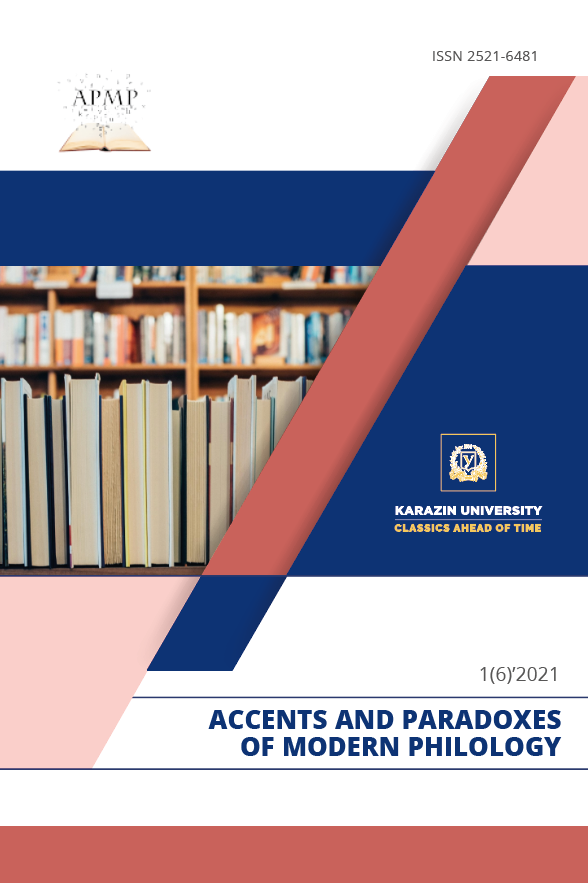АРХЕТИП ТРИКСТЕРА В СУЧАСНІЙ МЕДІАКУЛЬТУРІ: ШОУЇЗАЦІЯ ТА ДЕМОНІЗМ
Анотація
Статтю присвячено дослідженню архетипа Трикстера в медіакультурі сьогодення. Увагу в статті зосереджено на окремих літературних текстах ― надбаннях світової (С. Рушді «Золотий дім») й української словесності (В. Шкляр «Чорний Ворон»), кінофільмах («Джокер» (2019) Тодда Філіппса), персоналіях реального політикума (Дональд Трамп, В. Зеленський, пранкер Джокер та ін,) тощо, завдяки яким архетип Трикстера став одним із ключових у сучасному світовому й українському медіапросторі і житті. Так, у романі «Залишенець.Чорний Ворон» В. Шкляра ― постколоніальному втіленні травмованого російською експансію національного колективного несвідомого, у ролі Трикстера отаман-повстанець, захисник Холодного Яру, ― Чорний Ворон. В іншому творі, «Золотий дім» С. Рушді, Трикстера уособлюють герої-двійники – магнат Нерон Ґолден і Джокер. Останній балотувався на виборах на пост американського президента та отримав посаду. Твір за поетикою вкладається у схему готичного роману. Обидва персонажі ― готичні злодії, що демонструють «тіньовий» бік архетипа Трикстера. Образ Джокера тут тісно переплетений з американською реальністю у форматі кіно і шоу, де функція архетипу Трикстера присвоєна американському президенту Дональду Трампу, постать якого теж демонізується. В Україні функцію Трикстера бере на себе Президент України Володимир Зеленський ― комедійний актор і шоумен у супроводі колег по цеху зі «Студії Квартал ― 95». Атфосфера шоу овіює національну політику, життя та медіапростір. Негації нової влади віддзеркалюються у зловісних жартах над депутатами пранкера Джокера. Загальні світові тенденції до ескалації інфернальної сили архетипу Трикстера, пов’язані з мотивами абсурду, моторошного карнавалу і божевіллям, втілені у фільмі «Джокер» (2019), головний герой якого Артур Флек теж уособлює Трикстера. Тож у сучасному медіапросторі спостерігається взаємопроникнення семіотичних кодів ЗМІ, Інтернету, культури і реального життя. Особистість сприймає і відтворює ці знаки. Архетип Трикстера перетворився на мега медіаобраз в колективному несвідомому. Він сфокусував мотиви шоу та гри, набув демонічних рис на фоні дегуманізації людства і соціально-політичних негараздів.
Завантаження
Посилання
Ankhimova, R. (2015). Psychological features of mass media influence over the personality. International journal of experimental studies, № 3 (3). Pp.359 ―365. Retrieved from: https://www.expeducation.ru/ru/article/view?id=7154 (in rus)
BBC. News. Russian Service (2017). End of American dream? Salman Rushdie on his new novel. Retrieved from: https://www.bbc.com/russian/features-41530094. (in rus)
Bryant, Jennings, Thompson, Susan (2004). Fundamentals of Media Effects. Мoscow: Publishing house “Williams”, 432 p. (in rus)
The crow. Myths of the peoples of the world (1991). Encyclopedia in 2 volumes. Edited by S.А. Tokarev. М. Soviet encyclopedia. Vol.1. А― К. 671 p. (in rus)
Zborovska, N. (2006). The code of Ukrainian literature: the project of psycho-history of modern Ukrainian literature. Кyiv: Akademvydav,. 498 p. (in ukr)
Kyiv International Institute of Sociology (KIIS) (2020). Retrieved from: https://kiis.com.ua/?lang=ukr&cat=reports (in ukr)
Parimatch (2019). Retrieved from: https://social.bet/blog/bonus-3-000-rublej-ot-parimatch-na-premiyu-oskar/ (in rus)
Rushdie, S. (2019). The Golden House: novel. Lviv : Vydavnytstvo Starogo Leva. 496 p. (in ukr)
The Telegraph. News. Ukraine and world. Are you ready? A new epic story of insolent Conor McGregor (2019). Retrieved from : https://telegraf.com.ua/sport-cat/drugie-vidyi/5224969-ot-dzhokera-do-korolya-ringa-makgregor-snyalsya-v-novoy-reklamnoy-kampanii-video.html. (in rus)
Chernyakhovskaya, Y. V. (2004). Trickster or a journey into chaos. Chelovek, №3. 37 52 p. (in rus)
Denys Chyk, Olga Chyk (2017). “Who has ever deceived the moskal?” : the poem of “The Aeneid” by I. Kotliarevskyi in the context of the picaresque literature. Synopsis: text, context, media, No 3 (19), Borys Grinchenko Kyiv University. Retrieved from: https://synopsis.kubg.edu.ua/index.php/synopsis/article/view/264. (in ukr)
Jung, C.G. (1996). Soul and myth: six archetypes. Кyiv: State library of Ukraine for youth. 384 p. (in rus)
Fertel, R. Trickster (2018). His Apocalyptic Brother, and a World’s Unmaking: An Archetypal Reading of Donald Trump / from Jung's Red Book for Our Time: Searching for Soul Under Postmodern Conditions Volume 2, eds., Murray Stein and Thomas Arzt, Chiron Publications Retrieved from: https://papers.ssrn.com/sol3/papers.cfm?abstract_id=3212749.
Gerbner, G., Gross, L., Morgan, M., Signorielli, N. & Shanahan, J. (In press). Growing up with television: Cultivation processes. In Jеnning Bryant & Dolf. Zillmann (Eds.), Media effects: Advances in theory and research (2nd ed.). Mahwah, NJ: Erlbaum, 2002. 629 p.
Pein, C. (2016) Donald Trump, Trickster God. Retrieved from: https://thebaffler.com/magical-thinking/donald-trump-trickster-god




